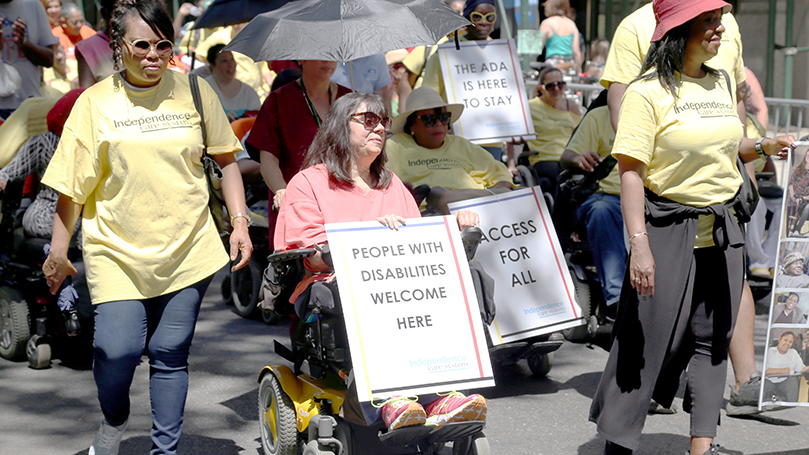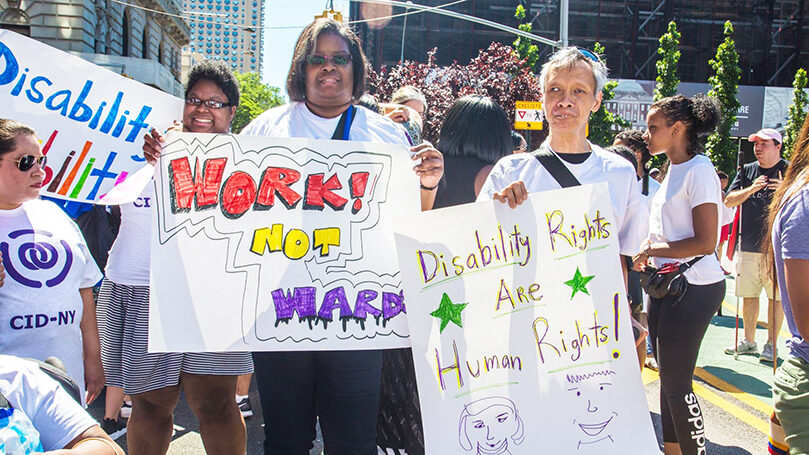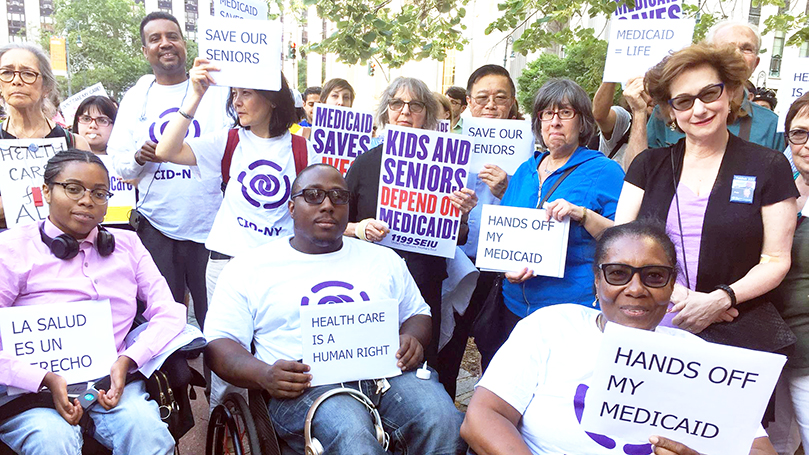
In its discussion of special oppression and exploitation , the CPUSA party program states the following:
The racially and nationally oppressed, women, youth, and immigrants all face types of special oppression, as do seniors, the Lesbian/Gay/Bisexual/Transgender/Queer (LGBTQ) community, and the disabled and mentally ill. All specially oppressed social groups are in their majority working class, but also include some members of other classes [emphasis added]. Those who are part of the working class suffer the exploitation and social problems of all other workers and, in addition, suffer from special oppression that is not solely based on class, such as racism, national discrimination, and male supremacy. Some people experience triple and quadruple oppression, since they face multiple layers of intense exploitation, discrimination, and social domination.
As the program indicates, people with disabilities are among those who face special forms of oppression in the U.S. According to the CDC, there are about 61 million adults with disabilities in the U.S., or one out of every four people. The CDC defines disability as “any condition of the body or mind” making it “more difficult for the person … to do certain activities, … and interact with the world around them.” The Census Bureau uses various survey questions about people’s daily lives to determine the size of the disabled population, putting that number at about 40.8 million.
However, the legal definition of disability, used by the Social Security Administration to determine eligibility for disability benefits, only includes those who are unable to do “any substantial gainful activity” because of a medically determined “physical or mental impairment” which could result in death, or which has lasted or could last for a year or more. This extremely narrow legal definition does not account for people who are temporarily impaired for less than a year, but who may still experience major disruptions in their lives that have long term effects.
Not surprisingly, the number of disabled people people receiving disability benefits is much lower than the actual number of disabled people (not to mention the woeful inadequacy of these programs to provide a livable income). Around 9.2 million people received disability benefits in 2021. Roughly 7.6 million people received disabled worker benefits in 2022. That number has been decreasing at an accelerating pace since 2015, and applicants overall have been denied support at an increasing rate since 2008. Termination rates have also increased.
The legal definition of disability shows how the U.S. government and ruling class see people with disabilities as possessing a problem that exists within their bodies, the chief problem being their reduced capacity to work. This specific definition is linked to the capitalist production process where the primary function of non-capitalists is to generate surplus value—and thus profits—for the capitalist class.

In contrast, the social model of disability, advocated for by disability rights organizations, argues that one’s relation to work isn’t the only measure of disability or ability. Rather, one’s ability to participate in family and community life is a more precise measure, and social adjustments and accommodations are the responsibility of social institutions. Without these supports, society is the disabling factor.
Disabling conditions exist on a spectrum. Not all people with disabilities share precisely the same conditions, even when they may share the same disease or impairment. For example, diabetes can be a deadly or debilitating disease. It can also be managed with careful attention to diet and proper medication.
The vast majority of people with disabilities are part of the working-class, and according to a National Disability Institute report, 27% of people with disabilities—and nearly 40% of African Americans with disabilities—live below the official poverty line. Painting a starker picture, a report from United For ALICE showed “more than half of all people with disabilities in the U.S.” were “struggling to afford essentials in the communities where they lived.”
Figures from the Organisation for Economic Co-operation and Development (OECD), an intergovernmental organization consisting of 38 member countries (many of whom are among the richest in the world), also report that nearly 50% of people with disabilities in the U.S. live in “income-poor households.” Among those countries, the U.S. has the widest inequality in incomes between households that include disabled people and households that do not.
The economic condition of people with disabilities across all the capitalist countries has deteriorated in the past few decades with the neoliberal erosion of social benefits, incomes, and access to living wages. For example, the National Disability Institute reports that deepening medical debt, significantly lower levels of educational attainment, and a crisis of food insecurity among people with disabilities, especially among people of color, surpass crisis proportions.
Since the pandemic, this situation, especially in the U.S., may have worsened. Some 7.7–23 million people are believed to be suffering from long COVID, or, as the Center for Disease Control states, “new, returning, or ongoing health problems that people experience after being infected with the virus that causes COVID-19.” Millions more may not even be aware of their condition, as the public health conversation has taken a sharp turn toward silence.
Many people experience symptoms so severe they are forced out of their jobs, or into part-time or temporary work, increasing their level of financial insecurity. In addition, the lack of resources being committed to public health in the U.S., especially in the context of the COVID-19 pandemic, increases the pressure on caregivers. Lack of access to quality health care and sick days forces millions of people to reduce their own quality of life by foregoing needed care, by self-medicating, or by reducing their work hours, leading, again, to greater financial hardship.

Capitalism harms people
Capitalists view population increases as generally necessary—insofar as people are able to work—in order for workers to produce surplus value, and in order to maintain other conditions favorable for Capital (such as maintaining an “optimal” unemployment rate). Thus, the deaths of more than 1 million people in a relatively short period of time, and the loss of another 1 million to the workforce due to long COVID, dramatically reduced the ability of the system to accumulate capital, producing a massive economic crisis, which even now remains barely manageable.
Capitalist production and accumulation relies on a certain level of unemployment—what Marx called the “industrial reserve army of labor”—to help drive down wages, to increase competition between workers and reduce their bargaining power, and in order to make it easier to replace “rebellious” workers. The current so-called tight labor market resulted not just from a spreading choice by workers to resist terribly exploitative conditions, but also from the significantly reduced numbers of workers able to hold consistent jobs due to the pandemic. These are issues the U.S. government no longer wants to talk about or address.
An increase in the number of people laboring for U.S. monopoly capital has taken place through a variety of factors, including normal population increases, immigration patterns, the historical inclusion of people gendered as women in the workforce, and the forceful opening of markets in non-capitalist and underdeveloped capitalist sectors around the world through imperialism. It has also been accomplished through various international financial, military, and political institutions controlled or dominated by the U.S., such as the IMF, NATO, AFRICOM, AUKUS, or the OAS. Global resistance to U.S. military domination has forced its retreat in some parts of the world—in Taiwan, Afghanistan, and Latin America, for example, while intensifying its aggression and dangers, such as in the Pacific region and in Eastern Europe.
White supremacy, heteronormative patriarchy, and national chauvinism are combined with these forms of domination to manage and control workers. They justify and propel deeper levels of exploitation, and promote class collaboration among some workers who have chosen to believe in the false idea that somehow their identity makes them superior to other people. But that tilt toward fascism and chauvinism is a dead end, and most workers reject it. Still, many remain confused by it.
When workers and other people are chronically ill, impaired, disabled, undernourished, elderly, children, or otherwise incapable of work, the ability to provide care depends on the availability of resources. However, most of these resources are only being realized as surplus value. This includes profits, investments for maintaining and expanding capital, and luxury consumption by capitalists.
While normal human compassion demands that we care for our loved ones and neighbors, capitalists have shown that they lack such compassion. Regardless of their personal values, the dynamics of capitalism force capitalists to compete with one another in order to remain capitalists—otherwise their business will ultimately lose out and be bought up by another, bigger capitalist. Thus, they treasure that almighty dollar more than human life. Indeed, the system itself—which demands that everything, even compassion, be commodified and turned into Capital—drives them to this barbaric worldview.
Images: 3rd Annual Disability Pride Parade by NYCDOT (CC BY-NC-ND 2.0); ADA all the way, work not wards by Center for Independence of the Disabled New York (Facebook); Healthcare is a human right by Center for Independence of the Disabled New York (Facebook)
- Tags:
- Disabiltiy
- inequality



 Join Now
Join Now